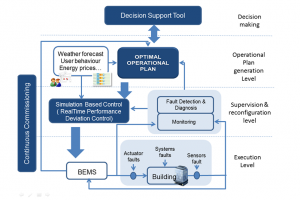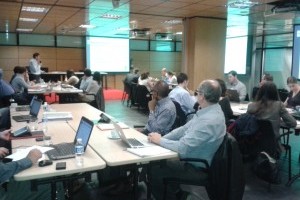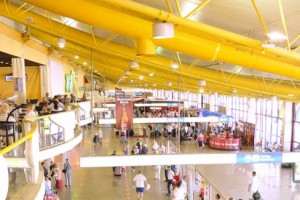The Energy IN TIME project work plan is divided into a total of nine work packages (WP), including six research work packages (WP1-6), one demo work package (WP7), and two more dedicated to dissemination and exploitation, and project coordination, respectively (WP8 & 9). The partners have already been hard at work in the first 6 months, as you can see from the individual work package progress reports below.
WP1: Requirements & System Architecture
The aim of this WP, which started in October 2013, is to analyze and identify target end-users and building requirements, define the system architecture and specifications and formulate a data acquisition methodology and guidelines for the composition of a communication platform. WP1 started in October 2013 and so far requirements and potential use cases for the Energy in Time solution have been defined. Questionnaires were distributed amongst the project partners and based on their feedback a list of modules that need to be developed was identified. These were then used to define the requirements for each individual module as well as the mutual dependencies between then, as well as to identify and describe potential use cases of the Energy in Time solution enabled by the individual modules. In addition to these internal project requirements, external requirements created by different climate conditions as well as different energy review methodologies across Europe have been summarised. So far two deliverables have been completed and submitted, namely D1.1 (Target Scenarios and User Requirements) and D1.2 (Energy Review Methodology).
WP2: Simulation Reference Model
This WP is focused on the development of advanced simulation tools for the analysis and characterization of buildings as a first stage in their management and optimized control. It will also design a forecast tool for user behaviour evolution and occupancy schedules that will be used to design the system models. WP2 started in January with Task 2.1 (Relevant parameter identification on energy models), which is due to be submitted as Deliverable 2.1 shortly. Currently we have run over 2000 simulations to analyse various parameters which are important for energy modelling. These will prioritised to determine which data is important for various building typologies in different climates. We have also begun to define Task 2.2 and are creating a specification for an energy auditing app which will be linked to the dynamic simulation model of the building. As such the parameters identified in T2.1 as important for collection will automatically be identified by the app once the user has answered some simple questions regarding the building typology, location and use. The app will then allow the user to collect this information and ‘tag’ it to the building as they conduct their walk through. This information will then be uploaded to the simulation reference model.
WP3: Whole building Intelligent Control System
This WP aims to develop an intelligent control system for whole-building energy optimization algorithms that minimizing energy consumption and peak demand while maintaining indoor comfort conditions. WP3 started in January 2014. Currently, UTRCI and ACCIONA are collaborating in the development of low-complexity models for HVAC control. These models will take into account current and predicted loads, user-behaviour patterns, weather forecasts, and simulation data. So far, a survey of the available literature on this topic has been developed. The development of the Intelligent Control System, led by University of Granada, is starting on April 2014. The first activities will be focused on the design of the system architecture, which is closely related to other components of the EiT solution, such as the energy simulation engine.
WP4: Diagnosis & Continuous Commissioning
The main aims of this WP are to develop procedures and algorithms for the detection and diagnosis of faults at system and equipment level, define a methodology for Continuous Commissioning and develop the procedures for the establishment of a predictive maintenance system. Work done so far includes the definition of detailed initial task requirements for the Fault Detection and Diagnostics, Continuous Commissioning, Structural Modelling and Predictive Maintenance, a joint effort by UTRCI, UL and CIT. Detailed use cases including the implementation framework for MO10 (fault detection and diagnostics) have been refined by UTCRI and the exploitation results pertaining to MO10 (fault detection and diagnostics) described, while UL developed a simulation model for building system using SIMBAD software. The Initial framework building of equipment and system level fault detection and diagnosis system has been initiated and the scope of operational and sensor fault detection and diagnosis is being developed.
WP5: Energy Decision Support Tool
WP 5 will take all the data gathered from different buildings, systems, devices, facilities, etc. and integrate it into a single information repository and decision support tool designed through data analysis and exploitation. This WP is scheduled to begin in January 2015.
WP6: System Integration & Pilot-Scale Validation
The objective of this WP is to integrate all the developments obtained from the previous WPs to generate the Energy IN TIME solution, including software tools and equipment. A system validation at laboratory scale will also be developed in this WP, which is scheduled to begin in July 2015.
WP7: Demonstration
WP7, led by Caverion, started in January 2014, and is closely connected to WP1, in which the energy review methodology to be used in the EiT demo sites is developed. The overall aim of WP7 is to implement and validate the EIT solution in real operated buildings. So far the ICPE has created two templates that were filled out for every demo-building in the EIT Project. The templates included the technical pilot characterizations of the existing energy systems and energy consumption characterizations in demo sites. The next step in Task 7.1 (Pilot Characterization) is to do the energy audit by implementing the energy review methodology defined in WP1. The energy audits will be performed during the next heating season (autumn 2014/winter 2015). Task 7.2 (System integration in the demonstrators) will start in October 2015 and the Task 7.3 (Monitoring and performance evaluation) in July 2016.
WP8: Dissemination & exploitation
The first six months are a crucial time for project dissemination, as it sets the stage for the rest of the project. This has therefore been a busy time for the WP leaders, FUNIBER. The main dissemination actions carried out in this initial stage of the project were the definition of the Energy IN TIME Corporate Identity and the creation of the official project Logo, the creation and launch of the project website and social networking accounts, the creation of an internal data management platform to facilitate communication between partners, and the definition of the Dissemination and Communication Plan for the remainder of the project. A highlight of the first six months has been the creation of this, the first Energy IN Time newsletter. As Exploitation Leaders, STAM has also been busy, organising, amongst others, the Exploitation Strategy Seminar to be held in conjunction with the 2nd International Meeting in Faro.
WP9: Coordination
The aim of this WP is to ensure effective technical, administrative, financial and legal management of the project in order to ensure that the project meet its goals and overall objective. Highlights of the first 6 months include the organisation and successful execution of the project Kick-off meeting, the definition of a detailed work plan, which was agreed upon by all partners at the kick-off meeting, and the preparation and signing of the Consortium Agreement. In addition, Deliverable D9.1 (Governance Structure, Communication flow and methods. Quality Plan) was completed and delivered in January 2014.º














